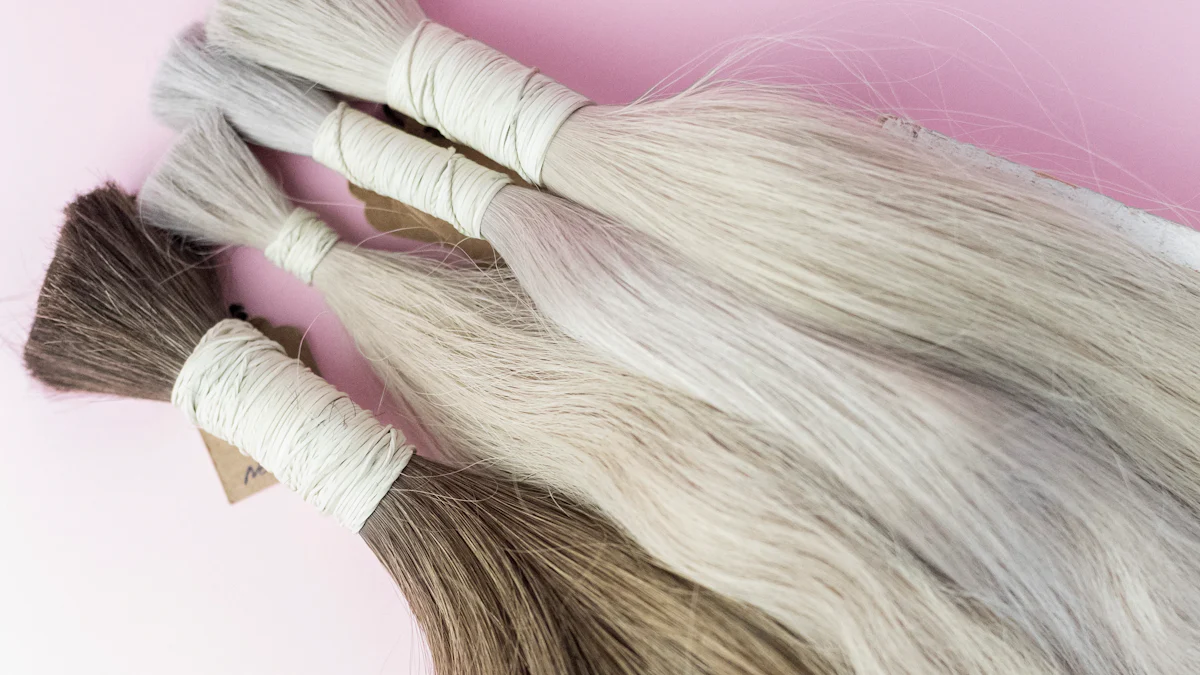Step-by-Step Guide to Applying a Lace Front Wig

Lace front wigs have become a popular choice for achieving a natural and glamorous look. Proper application of these wigs is crucial to ensure a seamless and realistic appearance. If you're wondering how to apply lace front wig, there are two main methods: using glue or going glueless. Each method offers unique benefits. Glue provides a secure hold, while the glueless option allows for frequent changes and is ideal for those with adhesive allergies. Understanding these techniques will help achieve the best results. For more tips and high-quality wigs, check out Luvmeforyou. Additionally, if you're curious about how long does a lace front wig last, it typically depends on the quality of the wig and how well it is maintained, but with proper care, it can last several months.
Preparing for Application
Gathering Supplies
Essential Tools and Products
To achieve a flawless lace front wig application, gather the necessary tools and products. Essential items include:
-
Wig stocking cap: Holds natural hair in place and creates a smooth surface.
-
Wig glue or got2b Glued Spray: Secures the wig firmly.
-
Rat-tail comb: Parts and styles the wig.
-
Alcohol prep pads or rubbing alcohol and cotton balls: Cleans and prepares the skin.
-
Nail cutting scissors: Cuts and customizes the wig.
-
Blow dryer with a “cool” setting: Dries and sets the wig.
Optional Accessories
Optional accessories can enhance the application process:
-
Bobby pins or hair clips: Secure the wig during styling.
-
Eyeliner in white: Marks the wig cap or skin for alignment.
-
Silk or satin scarf: Secures the wig and protects the edges.
-
Wide-tooth comb: Detangles and styles the wig.
-
Wig tape: Provides an alternative adhesive method.
-
Elastic band: Adjusts the fit of the wig.
-
Hairspray: Styles and sets the wig.
Prepping Your Natural Hair
Cleaning and Conditioning
Clean and condition natural hair before applying the wig. Use a gentle shampoo and conditioner to remove any dirt or oil. Dry the hair completely to prevent moisture buildup under the wig.
Braiding or Wrapping
Flatten natural hair by braiding or wrapping it. Cornrowing or slicking back the hair works well. This step ensures a smooth base for the wig.
Prepping the Wig
Cutting the Lace
Cut the lace carefully to match the natural hairline. Use nail cutting scissors for precision. Leave a small amount of lace to blend seamlessly with the skin.
Customizing the Hairline
Customize the hairline for a natural look. Pluck the hairline to create a more realistic appearance. Use a rat-tail comb to part and style the wig.
Applying the Wig with Glue

Protecting Your Skin
Using a Skin Protector
Protecting the skin is crucial when using glue to apply a Lace Front Wig. Apply a skin protector to the hairline area. This step minimizes irritation and provides a barrier between the adhesive and the skin. Patrick Evan, a PRO stylist from the Patrick Evan Salon in San Francisco, recommends using a product specifically designed for this purpose.
Applying a Wig Cap
A Wig Cap helps secure natural hair and creates a smooth base for the wig. Choose a cap that matches the skin tone. Place the cap over the head, ensuring all hair is tucked underneath. Adjust the cap to sit comfortably around the hairline.
Applying the Adhesive
Types of Adhesives
Different types of adhesives are available for securing a Lace Front Wig. Wig glue and wig tape are the most common options. Wig glue offers a strong hold, suitable for long-term wear. Wig tape provides an alternative for those who prefer a less permanent solution. Patrick Evan advises selecting an adhesive based on personal preference and skin sensitivity.
Application Techniques
Apply the adhesive carefully to ensure a secure fit. For wig glue, use a small brush to apply a thin layer along the hairline. Allow the glue to become tacky before positioning the wig. For wig tape, cut small pieces and place them along the hairline. Press the sticky side against the skin to secure.
Securing the Wig
Positioning the Wig
Position the Lace Front Wig carefully to achieve a natural look. Start by aligning the front of the wig with the natural hairline. Use a rat-tail comb to adjust the placement. Ensure the wig sits comfortably without pulling or causing discomfort.
Pressing and Securing
Press the lace front firmly against the adhesive to secure the wig. Use the back of a comb to press down the lace. This step ensures the wig adheres properly to the skin. Patrick Evan from the Patrick Evan Salon in San Francisco suggests using a blow dryer on a cool setting to help set the adhesive.
Finishing Touches
Blending the Hairline
Blending the hairline is an essential step to achieve a natural look. Use a rat-tail comb to gently pull out some baby hairs along the lace front. Pluck these hairs with tweezers for a more realistic appearance. Apply foundation or concealer that matches the skin tone to the lace. This technique helps the lace blend seamlessly with the scalp. A PRO TIP from Patrick Evan suggests using a makeup sponge for even application.
Styling the Wig
Styling the wig adds the final touch to the overall look. Use a wide-tooth comb to detangle the hair gently. Avoid pulling or tugging to prevent damage. Adjust the wig to ensure it sits comfortably on the head. Use a blow dryer on a cool setting to style the hair. Patrick Evan from the Patrick Evan Salon in San Francisco recommends using heat styling tools designed for human hair wigs. Apply a small amount of hairspray to set the style. For those who prefer a DIY lace front approach, adding accessories like headbands or clips can enhance the look.
Applying the Wig Without Glue
Using Adjustable Straps and Combs
Adjusting the Straps
Adjustable straps provide a secure fit for a Lace Front Wig without the need for adhesive. Locate the adjustable straps inside the wig cap. Use these straps to tighten or loosen the fit. Ensure the wig feels snug but not too tight.
Securing with Combs
Combs help keep the wig in place. Locate the combs inside the wig cap. Insert the combs into the natural hair. This step provides additional security. Adjust the placement of the combs for comfort.
Using Wig Grips
Types of Wig Grips
Wig grips come in various types. Some popular options include velvet wig grips and silicone wig grips. Velvet wig grips offer a soft and comfortable feel. Silicone wig grips provide a non-slip surface. Choose a wig grip based on personal preference.
Application Techniques
Apply the wig grip around the head. Position the grip along the hairline. Ensure the grip sits comfortably. Place the Lace Front Wig over the wig grip. Adjust the wig for a secure fit. The wig grip prevents slipping and shifting.
Using Elastic Bands
Sewing Elastic Bands
Elastic bands offer another method for securing a Lace Front Wig. Sew elastic bands inside the wig cap. Attach the bands near the ear tabs. Ensure the bands are tight enough to hold the wig in place.
Securing the Wig
Place the wig on the head. Adjust the elastic bands for a snug fit. Ensure the wig sits comfortably. The elastic bands provide a secure hold without adhesive.
Finishing Touches
Blending the Hairline
Blending the hairline is a crucial step to achieve a natural look. Use a rat-tail comb to gently pull out some baby hairs along the lace front. Pluck these hairs with tweezers for a more realistic appearance. Apply foundation or concealer that matches the skin tone to the lace. This technique helps the lace blend seamlessly with the scalp. A PRO TIP from Patrick Evan suggests using a makeup sponge for even application.
Patrick Evan, a PRO stylist from the Patrick Evan Salon in San Francisco, emphasizes the importance of blending the hairline. The right technique can make a significant difference in the overall appearance. For those who prefer a DIY lace front approach, adding a bit of foundation to the lace can help achieve a flawless look.
Styling the Wig
Styling the wig adds the final touch to the overall look. Use a wide-tooth comb to detangle the hair gently. Avoid pulling or tugging to prevent damage. Adjust the wig to ensure it sits comfortably on the head. Use a blow dryer on a cool setting to style the hair. Patrick Evan from the Patrick Evan Salon in San Francisco recommends using heat styling tools designed for human hair wigs. Apply a small amount of hairspray to set the style. For those who prefer a DIY lace front approach, adding accessories like headbands or clips can enhance the look.
Patrick Evan, a PRO stylist from the Patrick Evan Salon in San Francisco, advises using high-quality styling products. These products help maintain the integrity of the wig. A satin or silk scarf can protect the edges and keep the style intact.
"Although it’s taken six years to hone my skills to transform an obvious wig to a natural-looking style that even has my mother second-guessing whether it’s my hair or not, I’ve narrowed down the dos, don’ts and need-to-knows I’ve picked up along the way, from the school of YouTube and TikTok, from hair professionals to wig enthusiasts and through good ol’ trial and error…" - Anonymous
This testimonial highlights the importance of practice and learning from various sources. Achieving a natural look with a lace front wig requires attention to detail and the right techniques.
Maintenance and Care

Proper maintenance and care ensure a Lace Front Wig remains in excellent condition. Follow these steps to keep the wig looking natural and beautiful.
Daily Maintenance
Brushing and Detangling
Brush the wig daily to prevent tangles. Use a wide-tooth comb or a brush designed for wigs. Start from the ends and work up to the roots. Avoid pulling or tugging to prevent damage. Patrick Evan from the Patrick Evan Salon in San Francisco recommends gentle brushing to maintain the integrity of the hair.
Storing the Wig
Store the wig properly when not in use. Place it on a wig stand or mannequin head. This helps maintain the shape and style. Keep the wig in a cool, dry place away from direct sunlight. Patrick Evan suggests using a satin or silk scarf to cover the wig for added protection.
Washing and Conditioning
Frequency of Washing
Wash the wig regularly to keep it clean. The frequency depends on how often the wig is worn. For daily wear, wash the wig every two weeks. For occasional use, wash it once a month. Patrick Evan advises against over-washing as it can lead to dryness and damage.
Recommended Products
Use products specifically designed for wigs. Choose a mild shampoo and conditioner. Avoid products with harsh chemicals. Patrick Evan from the Patrick Evan Salon in San Francisco recommends using sulfate-free products. These products help maintain the softness and shine of the hair.
Long-term Care
Avoiding Damage
Avoid heat styling tools to prevent damage. If necessary, use tools designed for human hair wigs. Patrick Evan suggests using a blow dryer on a cool setting. Avoid exposing the wig to excessive heat or humidity. Store the wig properly to prevent tangling and frizz.
Extending the Lifespan
Extend the lifespan of the wig with proper care. Regularly trim the ends to prevent split ends. Patrick Evan from the Patrick Evan Salon in San Francisco recommends deep conditioning treatments. These treatments help maintain the softness and luster of the hair. Avoid using heavy styling products that can weigh down the hair.
"Proper care and maintenance can significantly extend the lifespan of a Lace Front Wig. Attention to detail and the right products make all the difference." - Patrick Evan
Follow these tips to keep the wig looking its best. Proper maintenance ensures a natural and beautiful appearance for months to come.
Recap the key steps to apply a Lace Front Wig. Gather essential tools and products. Prepare natural hair by cleaning and braiding. Protect the skin with a skin protector and a Wig Cap. Apply adhesive carefully. Position and secure the wig. Blend the hairline and style the wig. Practice and experiment with different techniques. Share experiences and tips in the comments. Co-authored by Patrick Evan, a PRO stylist from the Patrick Evan Salon in San Francisco.






















